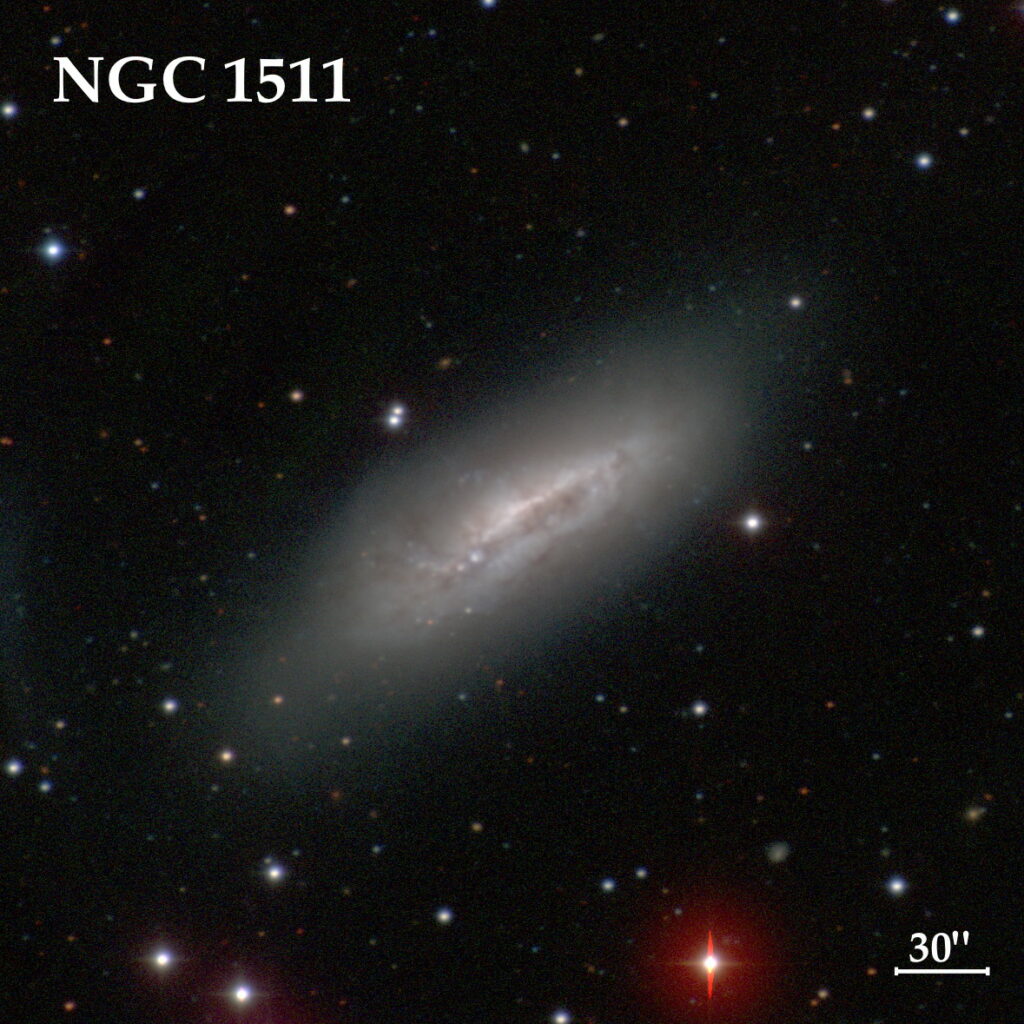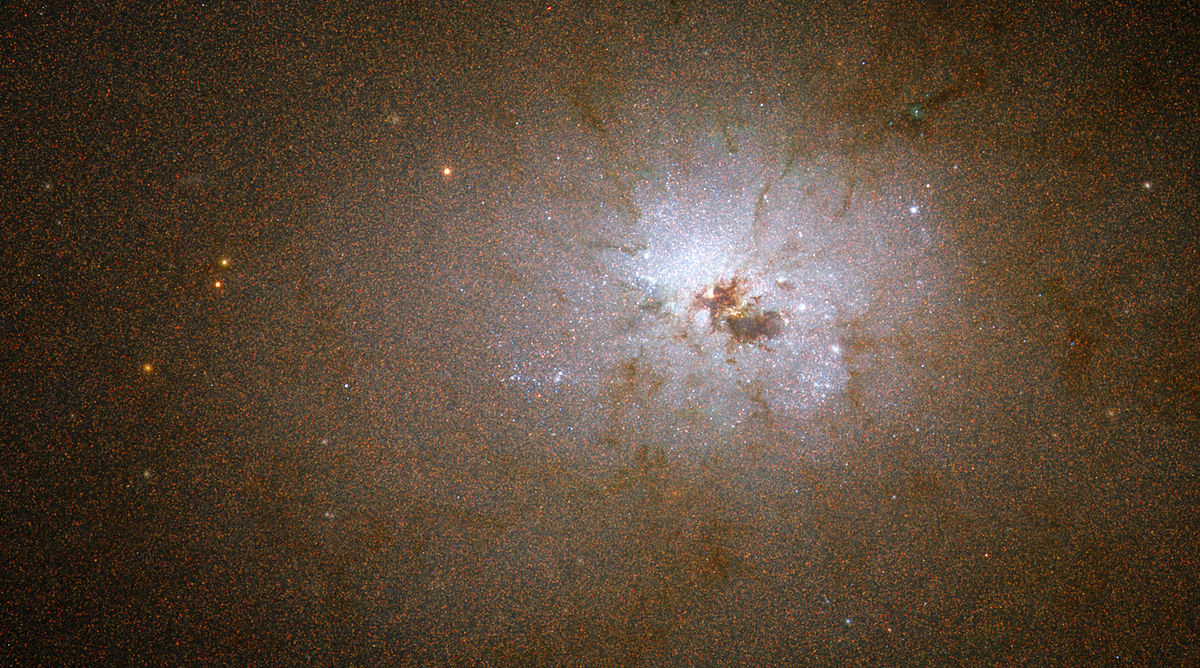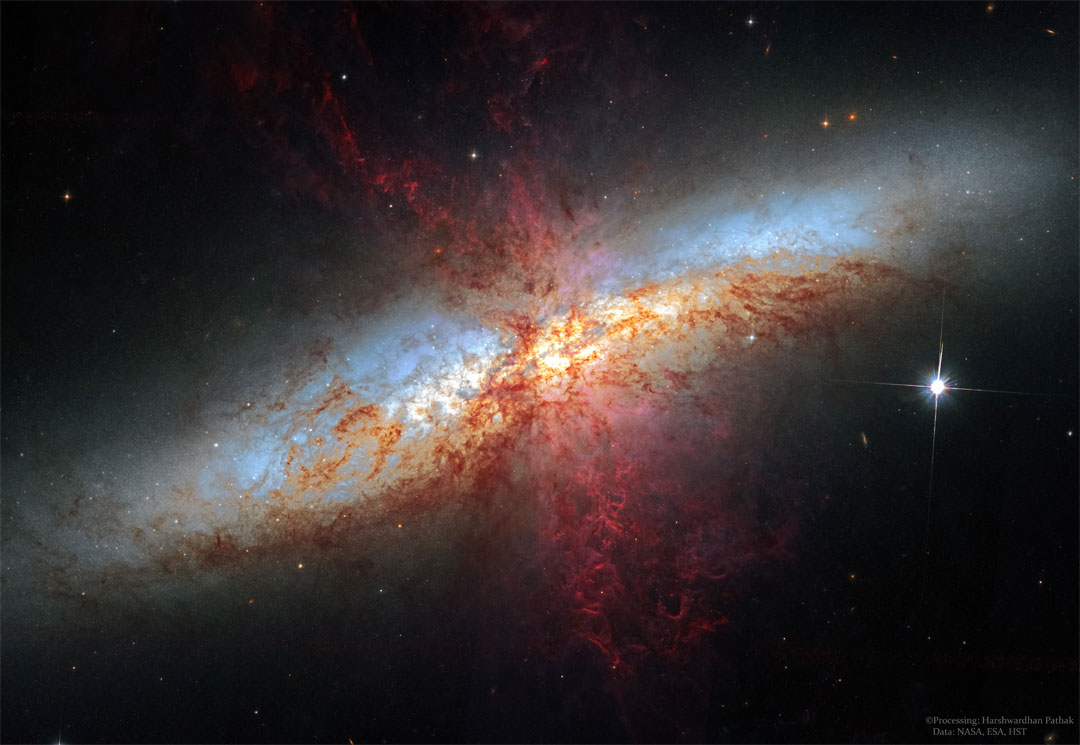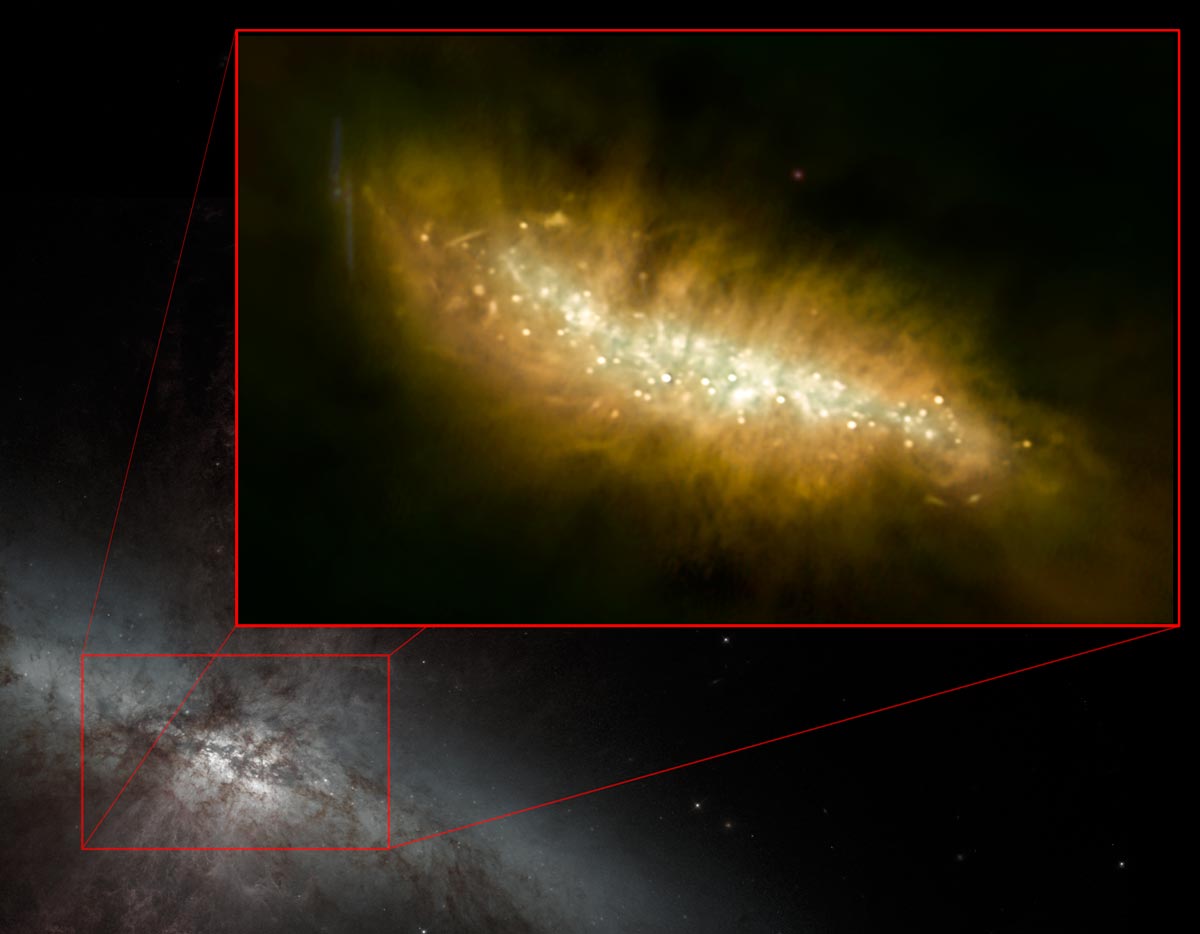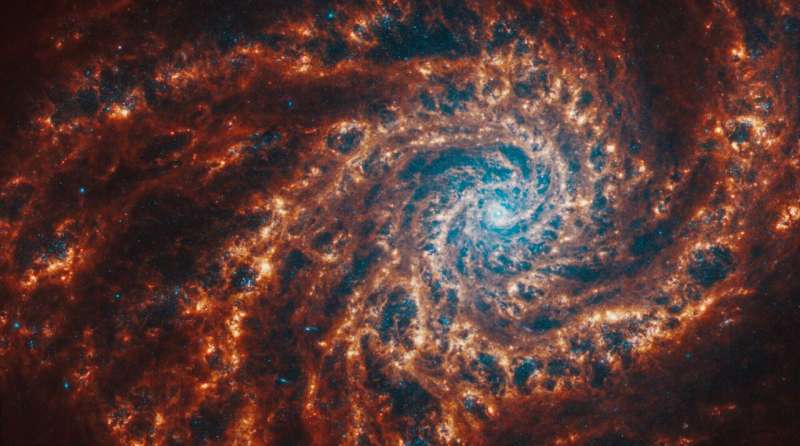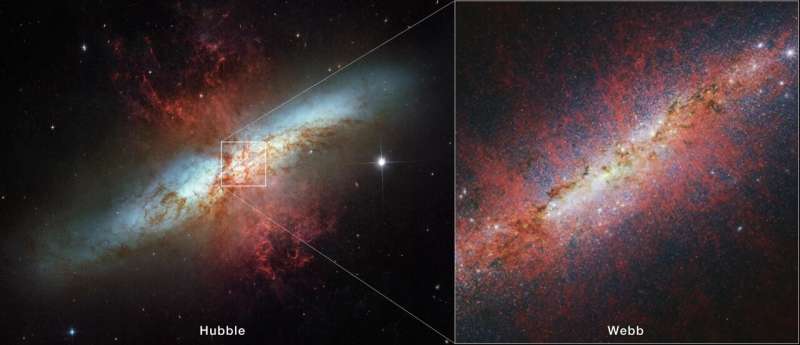Page 1 of 1
NewJWST: New Pictures from JWST
Posted: Sun Nov 26, 2023 8:52 pm
by AVAO
Re: NewJWST: New Pictures from JWST
Posted: Sun Nov 26, 2023 9:30 pm
by AVAO
NGC 1511
jac berne (flickr)
STScI Mikulski Archive | Release Date
2023 Nov 26
OBJECT
NGC 1511 is a spiral galaxy located in the constellation Aquarius. The measured velocity relative to cosmological space is 1,331 ± 5 km/s, corresponding to a Hubble distance of 19.6 ± 1.4 Mpc (∼63.9 million ly). It was discovered in 1834 by the British astronomer John Herschel. NGC 1511 is of type SB(s). NGC 1511 presents a large number of HI regions. Supernova SN 1935C was discovered in NGC 1524 on August 16 by American astronomer Emily Hughes Boyce7. The type of this supernova has not yet been determined. NGC 1511 is the largest and most brilliant galaxy of a trio of galaxies that bears its name. The other two galaxies in the group are NGC 1511, NGC 1473 and NGC 1511A (PGC 14255). In addition, the galaxy NGC 1511 is located in the same region of space as the galaxies NGC 1511A (ESO 55-5) and NGC 1511B (ESO 55-6).
Reply with quote
JWST4Y Jac
Re: NewJWST: New Pictures from JWST
Posted: Mon Nov 27, 2023 5:20 am
by Ann
AVAO wrote: ↑Sun Nov 26, 2023 9:30 pm
NGC 1511
jac berne (flickr)
STScI Mikulski Archive | Release Date
2023 Nov 26
OBJECT
NGC 1511 is a spiral galaxy located in the constellation Aquarius. The measured velocity relative to cosmological space is 1,331 ± 5 km/s, corresponding to a Hubble distance of 19.6 ± 1.4 Mpc (∼63.9 million ly). It was discovered in 1834 by the British astronomer John Herschel. NGC 1511 is of type SB(s). NGC 1511 presents a large number of HI regions. Supernova SN 1935C was discovered in NGC 1524 on August 16 by American astronomer Emily Hughes Boyce7. The type of this supernova has not yet been determined. NGC 1511 is the largest and most brilliant galaxy of a trio of galaxies that bears its name. The other two galaxies in the group are NGC 1511, NGC 1473 and NGC 1511A (PGC 14255). In addition, the galaxy NGC 1511 is located in the same region of space as the galaxies NGC 1511A (ESO 55-5) and NGC 1511B (ESO 55-6).
Reply with quote
JWST4Y Jac
Very interesting, Jac!

NGC 1511 appears to be one of those galaxies that undergo a burst of star formation near their centers, even though their visible outer regions are yellow, old and smooth. I found this picture of it by The Carnegie-Irvine Galaxy Survey:
You can see the active gas and dust-rich inner disk (or ring?) of NGC 1511, surrounded by a relatively large, smooth envelope. There are several galaxies with active interiors and smooth envelopes:
And there is the remarkable NGC 4314:
Note that NGC 4314 is a very well-formed grand design barred spiral galaxy that is completely "red and dead", except for a tiny ring surrounding its core!
And of course, there is the "mother of all central starburst galaxies", M82!
We sure need Webb to take a look at M82!
Again, thank you for posting these fascinating pictures, Jac!
Ann
Re: NewJWST: New Pictures from JWST
Posted: Mon Nov 27, 2023 6:56 am
by AVAO
Ann wrote: ↑Mon Nov 27, 2023 5:20 am
AVAO wrote: ↑Sun Nov 26, 2023 9:30 pm
NGC 1511
jac berne (flickr)
STScI Mikulski Archive | Release Date
2023 Nov 26
OBJECT
NGC 1511 is a spiral galaxy located in the constellation Aquarius. The measured velocity relative to cosmological space is 1,331 ± 5 km/s, corresponding to a Hubble distance of 19.6 ± 1.4 Mpc (∼63.9 million ly). It was discovered in 1834 by the British astronomer John Herschel. NGC 1511 is of type SB(s). NGC 1511 presents a large number of HI regions. Supernova SN 1935C was discovered in NGC 1524 on August 16 by American astronomer Emily Hughes Boyce7. The type of this supernova has not yet been determined. NGC 1511 is the largest and most brilliant galaxy of a trio of galaxies that bears its name. The other two galaxies in the group are NGC 1511, NGC 1473 and NGC 1511A (PGC 14255). In addition, the galaxy NGC 1511 is located in the same region of space as the galaxies NGC 1511A (ESO 55-5) and NGC 1511B (ESO 55-6).
Reply with quote
JWST4Y Jac
Very interesting, Jac!

NGC 1511 appears to be one of those galaxies that undergo a burst of star formation near their centers, even though their visible outer regions are yellow, old and smooth. I found this picture of it by The Carnegie-Irvine Galaxy Survey:
You can see the active gas and dust-rich inner disk (or ring?) of NGC 1511, surrounded by a relatively large, smooth envelope. There are several galaxies with active interiors and smooth envelopes:
And there is the remarkable NGC 4314:
Note that NGC 4314 is a very well-formed grand design barred spiral galaxy that is completely "red and dead", except for a tiny ring surrounding its core!
And of course, there is the "mother of all central starburst galaxies", M82!
We sure need Webb to take a look at M82!
Again, thank you for posting these fascinating pictures, Jac!
Ann
Cool ThanX Ann 4 your comments!
For me the faint arc in the circle is also a very interesting feature.
The question also arises as to which object is the cause of the large hole in NGC1511's lower arm, which only becomes fully visible in the IR-range of JWST.
Picture source: DSS2
Re: NewJWST: New Pictures from JWST
Posted: Mon Nov 27, 2023 9:37 am
by Ann
AVAO wrote: ↑Mon Nov 27, 2023 6:56 am
Ann wrote: ↑Mon Nov 27, 2023 5:20 am
Very interesting, Jac!

NGC 1511 appears to be one of those galaxies that undergo a burst of star formation near their centers, even though their visible outer regions are yellow, old and smooth. I found this picture of it by The Carnegie-Irvine Galaxy Survey:
You can see the active gas and dust-rich inner disk (or ring?) of NGC 1511, surrounded by a relatively large, smooth envelope. There are several galaxies with active interiors and smooth envelopes:
And there is the remarkable NGC 4314:
Note that NGC 4314 is a very well-formed grand design barred spiral galaxy that is completely "red and dead", except for a tiny ring surrounding its core!
And of course, there is the "mother of all central starburst galaxies", M82!
We sure need Webb to take a look at M82!
Again, thank you for posting these fascinating pictures, Jac!
Ann
Cool ThanX Ann 4 your comments!
For me the faint arc in the circle is also a very interesting feature.
The question also arises as to which object is the cause of the large hole in NGC1511's lower arm, which only becomes fully visible in the IR-range of JWST.
Picture source: DSS2
I would guess that the elongated faint feature next to NGC 1511 is a stellar stream, somewhat similar to what is seen surrounding NGC 5907:
The hole in one of the arms of NGC 1511 is more mysterious, but it reminds me at least a little of some of the dark holes in M74 that were revealed by JWST:
Ann
Re: NewJWST: New Pictures from JWST
Posted: Mon Nov 27, 2023 10:02 am
by Ann
An interesting galaxy with a "hole" in one of its arms is NGC 2997:
A hole in NGC 2997? Image credit:
Rainer Sparenberg, Stefan Binnewies, Volker Robering
Ann
Re: NewJWST: New Pictures from JWST
Posted: Mon Nov 27, 2023 5:08 pm
by AVAO
Ann wrote: ↑Mon Nov 27, 2023 10:02 am
An interesting galaxy with a "hole" in one of its arms is NGC 2997:
NGC 2997 annotated Rainer Sparenberg Stefan Binnewies Volker Robering.png
A hole in NGC 2997? Image credit:
Rainer Sparenberg, Stefan Binnewies, Volker Robering
Ann
ThanX Ann
I think your comparisons are very appropriate.
Jac
Re: NewJWST: New Pictures from JWST
Posted: Thu Nov 30, 2023 5:08 am
by AVAO
Congratulation - Great processing!
Image & Description by Go Webb! (Unofficial)
Credit: All image rights belong to the author
Original Data Source: NASA/ESA/CSA
Date: 11/28/2023
Go Webb! (Unofficial) | NGC 1511: NIRCAM
PID 3707, 2023.11.25
NGC 1511 - Spiral Galaxy in the Hydrus constellation:
03:59:36.590 -67:38:02.15
F150W Blue
F300M Green
F335M Red
F770W Red
Re: NewJWST: New Pictures from JWST
Posted: Thu Nov 30, 2023 5:21 pm
by Ann
AVAO wrote: ↑Thu Nov 30, 2023 5:08 am
Congratulation - Great processing!
Image & Description by Go Webb! (Unofficial)
Credit: All image rights belong to the author
Original Data Source: NASA/ESA/CSA
Date: 11/28/2023
Go Webb! (Unofficial) | NGC 1511: NIRCAM
PID 3707, 2023.11.25
NGC 1511 - Spiral Galaxy in the Hydrus constellation:
03:59:36.590 -67:38:02.15
F150W Blue
F300M Green
F335M Red
F770W Red
Wow! It looks amazing!
Ann
Re: NewJWST: New Pictures from JWST
Posted: Sat Dec 09, 2023 6:35 am
by AVAO
Congratulation - Great processing!
"...James Webb took some images of the galaxy cluster MACS J0138.0-2155. This cluster is so massive that it distorts the light coming from behind it so strongly, we see it as a smudged stain. A phenomena caused by this effect is the cluster magnifies the light coming from behind it, like a magnifying glass. A research group used Webb to observe this cluster using its near infrared camera (NIRCam). They chose this instrument because the distorted light is so distant (a few billion light years away from us), and it gest redshifted. Webb's great sensitivity in infrared light is perfect for such mission. The main reason this group proposed this observation was to study a very distant supernova candidate.
According to the group, this object is seen 5 times(!) in the image, due to the strong gravitational lensing and has a redshift of z=1.95, which translated to over 7 billion light years away. In addition,
this object is in a galaxy the contains another lensed supernova (SN Requiem). Therefore, they named the supernova "Encore"."
https://www.reddit.com/user/JwstFeedOfficial/
If confirmed, this will be the first time in history we observed a system that produced more than one lensed supernova.
Image & Description by Go Webb! (Unofficial)
Credit: All image rights belong to the author
Original Data Source: NASA/ESA/CSA
Date: 11/28/2023
Go Webb! (Unofficial) | MACS J0138.0-2155: NIRCam
PID 6549, 2023.12.05
MACS J0138.0-2155 quintuple-lensing cluster, home to SN Requiem, and now SN Encore: 01:38:02.160 -21:55:22.41
F150W Blue
F277W Green
F356W Orange
F444W Red
Re: NewJWST: New Pictures from JWST
Posted: Sat Dec 09, 2023 10:38 am
by Ann
AVAO wrote: ↑Sat Dec 09, 2023 6:35 am
Congratulation - Great processing!
"...James Webb took some images of the galaxy cluster MACS J0138.0-2155. This cluster is so massive that it distorts the light coming from behind it so strongly, we see it as a smudged stain. A phenomena caused by this effect is the cluster magnifies the light coming from behind it, like a magnifying glass. A research group used Webb to observe this cluster using its near infrared camera (NIRCam). They chose this instrument because the distorted light is so distant (a few billion light years away from us), and it gest redshifted. Webb's great sensitivity in infrared light is perfect for such mission. The main reason this group proposed this observation was to study a very distant supernova candidate.
According to the group, this object is seen 5 times(!) in the image, due to the strong gravitational lensing and has a redshift of z=1.95, which translated to over 7 billion light years away. In addition,
this object is in a galaxy the contains another lensed supernova (SN Requiem). Therefore, they named the supernova "Encore"."
https://www.reddit.com/user/JwstFeedOfficial/
If confirmed, this will be the first time in history we observed a system that produced more than one lensed supernova.
Image & Description by Go Webb! (Unofficial)
Credit: All image rights belong to the author
Original Data Source: NASA/ESA/CSA
Date: 11/28/2023
Go Webb! (Unofficial) | MACS J0138.0-2155: NIRCam
PID 6549, 2023.12.05
MACS J0138.0-2155 quintuple-lensing cluster, home to SN Requiem, and now SN Encore: 01:38:02.160 -21:55:22.41
F150W Blue
F277W Green
F356W Orange
F444W Red
Amazing, Jac!
I'd love to see a labeled version of this, where you can see the possible supernova(s).
Ann
Re: NewJWST: New Pictures from JWST
Posted: Wed Jan 31, 2024 6:46 am
by AVAO
Ann wrote: ↑Sat Dec 09, 2023 10:38 am
AVAO wrote: ↑Sat Dec 09, 2023 6:35 am
Congratulation - Great processing!
"...James Webb took some images of the galaxy cluster MACS J0138.0-2155. This cluster is so massive that it distorts the light coming from behind it so strongly, we see it as a smudged stain. A phenomena caused by this effect is the cluster magnifies the light coming from behind it, like a magnifying glass. A research group used Webb to observe this cluster using its near infrared camera (NIRCam). They chose this instrument because the distorted light is so distant (a few billion light years away from us), and it gest redshifted. Webb's great sensitivity in infrared light is perfect for such mission. The main reason this group proposed this observation was to study a very distant supernova candidate.
According to the group, this object is seen 5 times(!) in the image, due to the strong gravitational lensing and has a redshift of z=1.95, which translated to over 7 billion light years away. In addition,
this object is in a galaxy the contains another lensed supernova (SN Requiem). Therefore, they named the supernova "Encore"."
https://www.reddit.com/user/JwstFeedOfficial/
If confirmed, this will be the first time in history we observed a system that produced more than one lensed supernova.
Image & Description by Go Webb! (Unofficial)
Credit: All image rights belong to the author
Original Data Source: NASA/ESA/CSA
Date: 11/28/2023
Go Webb! (Unofficial) | MACS J0138.0-2155: NIRCam
PID 6549, 2023.12.05
MACS J0138.0-2155 quintuple-lensing cluster, home to SN Requiem, and now SN Encore: 01:38:02.160 -21:55:22.41
F150W Blue
F277W Green
F356W Orange
F444W Red
Amazing, Jac!
I'd love to see a labeled version of this, where you can see the possible supernova(s).
Ann
Three Times a Charm: Hubble Spots Three Images of a Distant Supernova
Credit: Joseph DePasquale (STScI)
more:
https://hubblesite.org/contents/media/i ... nd-nebulas
NASA’s Webb Spots a Second Lensed Supernova in a Distant Galaxy
Credit: NASA, ESA, CSA, STScI, Justin Pierel (STScI) and Andrew Newman (Carnegie Institution for Science).
more:
https://webbtelescope.org/contents/earl ... ant-galaxy
Re: NewJWST: New Pictures from JWST
Posted: Wed Jan 31, 2024 7:46 am
by Ann
AVAO wrote: ↑Wed Jan 31, 2024 6:46 am
Ann wrote: ↑Sat Dec 09, 2023 10:38 am
AVAO wrote: ↑Sat Dec 09, 2023 6:35 am
Congratulation - Great processing!
"...James Webb took some images of the galaxy cluster MACS J0138.0-2155. This cluster is so massive that it distorts the light coming from behind it so strongly, we see it as a smudged stain. A phenomena caused by this effect is the cluster magnifies the light coming from behind it, like a magnifying glass. A research group used Webb to observe this cluster using its near infrared camera (NIRCam). They chose this instrument because the distorted light is so distant (a few billion light years away from us), and it gest redshifted. Webb's great sensitivity in infrared light is perfect for such mission. The main reason this group proposed this observation was to study a very distant supernova candidate.
According to the group, this object is seen 5 times(!) in the image, due to the strong gravitational lensing and has a redshift of z=1.95, which translated to over 7 billion light years away. In addition,
this object is in a galaxy the contains another lensed supernova (SN Requiem). Therefore, they named the supernova "Encore"."
https://www.reddit.com/user/JwstFeedOfficial/
If confirmed, this will be the first time in history we observed a system that produced more than one lensed supernova.
Image & Description by Go Webb! (Unofficial)
Credit: All image rights belong to the author
Original Data Source: NASA/ESA/CSA
Date: 11/28/2023
Go Webb! (Unofficial) | MACS J0138.0-2155: NIRCam
PID 6549, 2023.12.05
MACS J0138.0-2155 quintuple-lensing cluster, home to SN Requiem, and now SN Encore: 01:38:02.160 -21:55:22.41
F150W Blue
F277W Green
F356W Orange
F444W Red
Amazing, Jac!
I'd love to see a labeled version of this, where you can see the possible supernova(s).
Ann
Three Times a Charm: Hubble Spots Three Images of a Distant Supernova
Credit: Joseph DePasquale (STScI)
more:
https://hubblesite.org/contents/media/i ... nd-nebulas
NASA’s Webb Spots a Second Lensed Supernova in a Distant Galaxy
Credit: NASA, ESA, CSA, STScI, Justin Pierel (STScI) and Andrew Newman (Carnegie Institution for Science).
more:
https://webbtelescope.org/contents/earl ... ant-galaxy
Thanks a bunch, Jac, so fascinating!
Ann
Re: NewJWST: New Pictures from JWST
Posted: Sun Feb 18, 2024 11:34 am
by AVAO
Spiral galaxy NGC 4254's dazzling swirls
phys.org | 2024 Feb 13
I
t's oh-so-easy to be mesmerized by this spiral galaxy. Follow its clearly defined arms, which are brimming with stars, to its center, where there may be old star clusters and—sometimes—active supermassive black holes. NASA's James Webb Space Telescope delivered highly detailed scenes of this and other nearby spiral galaxies in a combination of near- and mid-infrared light.
"NGC 4254, a spiral galaxy, is resplendent in orange and blue in this Jan. 29, 2024, image from the James Webb Space Telescope. [...] Webb's Near-Infrared Camera captured millions of stars in these images, which sparkle in blue tones, while the telescope's Mid-Infrared Instrument data highlights glowing dust, showing us where it exists around and between stars."
read more
download
JWST4Y Jac
Re: NewJWST: New Pictures from JWST
Posted: Wed Mar 13, 2024 5:08 am
by AVAO
Peering Into the Tendrils of NGC 604 With NASA’s Webb
NASA/JPL | 2024 March 11
A well-studied hotbed of star formation is revealed in new detail by two of the telescope’s instruments, including MIRI, which was managed through launch by JPL. The formation of stars and the chaotic environments they inhabit is one of the most well-studied, but also mystery-shrouded, areas of cosmic investigation. The intricacies of these processes are now being unveiled like never before by NASA’s James Webb Space Telescope.
Two new images from Webb’s NIRCam (Near-Infrared Camera) and MIRI (Mid-Infrared Instrument) showcase star-forming region NGC 604, located in the Triangulum galaxy (M33), 2.73 million light-years away from Earth. In these images, cavernous bubbles and stretched-out filaments of gas etch a more detailed and complete tapestry of star birth than seen in the past.
read more
JWST4Y Jac
This image from Webb’s MIRI (Mid-Infrared Instrument) of star-forming region NGC 604 shows how large clouds of cooler gas and dust glow in mid-infrared wavelengths. This region is home to more than 200 of the hottest, most massive kinds of stars, all in the early stages of their lives. Credit: NASA, ESA, CSA, STScI
Re: NewJWST: New Pictures from JWST
Posted: Thu Apr 04, 2024 5:48 am
by AVAO
Webb probes an extreme starburst galaxy
phys.org | 2024 April 03
A team of astronomers has used NASA's James Webb Space Telescope to survey the starburst galaxy Messier 82 (M82). Located 12 million light-years away in the constellation Ursa Major, this galaxy is relatively compact in size but hosts a frenzy of star formation activity. For comparison, M82 is sprouting new stars 10 times faster than the Milky Way galaxy.
" [...] One area of focus for this research team was understanding how this galactic wind, which is caused by the rapid rate of star formation and subsequent supernovae, is being launched and influencing its surrounding environment. By resolving a central section of M82, scientists could examine where the wind originates, and gain insight on how hot and cold components interact within the wind. [...]"
read more
download
slider
JWST4Y Jac
Re: NewJWST: New Pictures from JWST
Posted: Sun Apr 21, 2024 8:31 pm
by AVAO
NGC 3972
jac berne (flickr)
STScI Mikulski Archive | Release Date
2024-04-19 18:23
NGC 3972 is a spiral galaxy located in the northern constellation of Ursa Major. It was discovered by William Herschel on April 14, 1789.This galaxy is located 66 million light years away and is receding with a heliocentric radial velocity of 846 km/s. It is a member of the NGC 3992 Group of galaxies.
Reply with quote
JWST4Y Jac
Re: NewJWST: New Pictures from JWST
Posted: Mon Apr 22, 2024 5:20 am
by Ann
AVAO wrote: ↑Sun Apr 21, 2024 8:31 pm
NGC 3972
jac berne (flickr)
STScI Mikulski Archive | Release Date
2024-04-19 18:23
NGC 3972 is a spiral galaxy located in the northern constellation of Ursa Major. It was discovered by William Herschel on April 14, 1789.This galaxy is located 66 million light years away and is receding with a heliocentric radial velocity of 846 km/s. It is a member of the NGC 3992 Group of galaxies.
Reply with quote
JWST4Y Jac
So interesting, Jac! NGC 3972 is a relatively blue galaxy with a good amount of star formation. Its B-V index is 0.66, and its U-B index is —0.04. This is rather blue for a galaxy, whose "average" B-V index might be closer to 0.70 to 0.75 and its U-B index might be closer to, say, +0.10. NGC 3972 is somewhat brighter in the far infrared than at B wavelengths, which is a sign of healthy star formation. And indeed, the HST(?) image looks very dusty, and there are a lot of blue stars there. In fact, the HST image looks somewhat chaotic.
How different is the JWST image! We see the elegant "backbone" of the galaxy, the mass concentration in the form of billions of cool low-mass stars in the well-formed arms.
Fantastic! It is as if the small red stars are the "cake" of NGC 3972, and the starry blue fluff and all the dust is just the icing of the cake!
Ann
Re: NewJWST: New Pictures from JWST
Posted: Sun Apr 28, 2024 7:41 pm
by AVAO
NGC 2775
jac berne (flickr)
Original data: NASA/ESA/CSA
Re: NewJWST: New Pictures from JWST
Posted: Mon Apr 29, 2024 3:58 am
by Ann
AVAO wrote: ↑Sun Apr 28, 2024 7:41 pm
NGC 2775
jac berne (flickr)
Original data: NASA/ESA/CSA
Have you yourself processed the NASA/ESA/CSA data to produce this image, Jac? It's glorious! And NGC 2775 is such a weird and interesting galaxy.
Ann
Re: NewJWST: New Pictures from JWST
Posted: Mon Apr 29, 2024 7:24 pm
by AVAO
Ann wrote: ↑Mon Apr 29, 2024 3:58 am
AVAO wrote: ↑Sun Apr 28, 2024 7:41 pm
NGC 2775
jac berne (flickr)
Original data: NASA/ESA/CSA
Have you yourself processed the NASA/ESA/CSA data to produce this image, Jac? It's glorious! And NGC 2775 is such a weird and interesting galaxy.
Ann
ThanX Ann
Definitely too much of an honor.
But yes, the pictures are mine. In contrast to Geck or other image processors, I work primarily according to aesthetic principles. Here I was particularly interested in the “middle” wavelengths (e.g. F770) because that is where the most spatial details can be found. Classically, an RGB image would be composed of image material from the near (NIRCAM blue), intermediate (green) and middle (MIRI red) or use the colors assigned by NASA to the individual wavelengths. In the case of NGC 2775, these versions didn't convince me enough, so I "borrowed" the colors from HST and SSDS, which then makes them completely scientifically worthless. But since that wasn't my intention, it doesn't matter to me...
In a way it's a special kind of a WEBBLE

Jac
Compare to:
https://bsky.app/profile/jwstfeed.bsky. ... qk7wgzik25
https://twitter.com/hamidhassani_ir/sta ... 6028465324
...
Re: NewJWST: New Pictures from JWST
Posted: Mon Apr 29, 2024 7:49 pm
by Ann
AVAO wrote: ↑Mon Apr 29, 2024 7:24 pm
Ann wrote: ↑Mon Apr 29, 2024 3:58 am
AVAO wrote: ↑Sun Apr 28, 2024 7:41 pm
NGC 2775
jac berne (flickr)
Original data: NASA/ESA/CSA
Have you yourself processed the NASA/ESA/CSA data to produce this image, Jac? It's glorious! And NGC 2775 is such a weird and interesting galaxy.
Ann
ThanX Ann
Definitely too much of an honor.
But yes, the pictures are mine. In contrast to Geck or other image processors, I work primarily according to aesthetic principles. Here I was particularly interested in the “middle” wavelengths (e.g. F770) because that is where the most spatial details can be found. Classically, an RGB image would be composed of image material from the near (NIRCAM blue), intermediate (green) and middle (MIRI red) or use the colors assigned by NASA to the individual wavelengths. In the case of NGC 2775, these versions didn't convince me enough, so I "borrowed" the colors from HST and SSDS, which then makes them completely scientifically worthless. But since that wasn't my intention, it doesn't matter to me...
In a way it's a special kind of a WEBBLE

Jac
Compare to:
https://bsky.app/profile/jwstfeed.bsky. ... qk7wgzik25
https://twitter.com/hamidhassani_ir/sta ... 6028465324
...
Your images may or may not be scientifically valuable, but they sure are stunning! And I would take your version of NGC 2775 any day over the "scientific" ones you linked to!
Ann
Re: NewJWST: New Pictures from JWST
Posted: Sat Jun 01, 2024 8:54 am
by AVAO
JWST spots starburst galaxy
phys.org | 2024 May 30
A dwarf galaxy. It is illuminated by a strong, cool light radiating from its core, a bar-shaped area at the centre, and filled with a huge number of visible stars that appear as tiny glowing points. Faint wisps and clouds of dust wind around and through the galaxy’s core. Some are lit up by star-forming regions inside them. Many small, distant galaxies can be seen through and around the dwarf galaxy.
The James Webb Space Telescope observed the "starburst" galaxy NGC 4449, seen in this image released on May 29, 2024. Starbursts are intense periods of star formation usually concentrated at a galaxy's core, but NGC 4449's activity is much more widespread—likely due to past interactions with its galactic neighbors. Astronomers can study this galaxy to look into the past: NGC 4449 is similar to early star-forming galaxies, which also grew by merging with other systems.
NASA: ESA: NGC 4449 resembles primordial star-forming galaxies which grew by merging with and accreting smaller stellar systems. Since NGC 4449 is close enough to be observed in great detail, it is the ideal laboratory for astronomers to study what may have occurred during galaxy formation and evolution in the early Universe.
bigg:
https://de.wikipedia.org/wiki/NGC_4449# ... scope).jpg
Credit: NASA, ESA, A. Aloisi (STScI/ESA), and The Hubble Heritage (STScI/AURA)-ESA/Hubble Collaboration
read more
NASA/ESA
download[/b]
JWST4Y Jac


